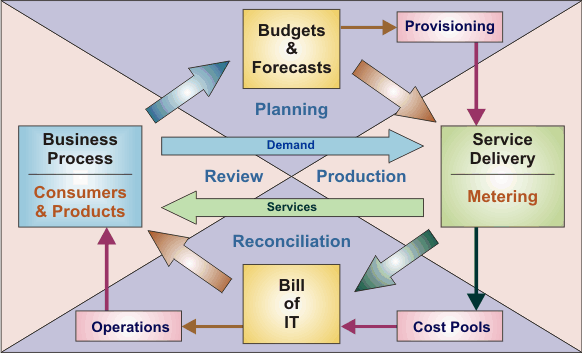Business Based
The ability to link IT costs
to the business must be
accomplished within the
framework of traditional
business procedures. This
can include the use of
budgets, cost/price
analysis, benchmarking, or
other business techniques.
Common Information Base
Effective communication
between the business
consumer and IT depends
on a common set of
information that contains
different views. The views
must accommodate the
business perspective, IT
perspective, and have the
ability to present
information that can be
understood by all
participants.
Continuous Process
The linking of IT costs to
the business is not a single
event, but rather a
continuous process. It
must regularly measure
and review the use of IT
for service delivery, and
provide business based
information that allows for
the effective provisioning
of resources for these
services.
Planning
The planning process is a joint process between the business consumers and IT operations. In order
for this process to work, the two sides must be able to communicate in terms that are understood by
both. In the past, the IT group would only provide metrics in technical terms that were not
understood by the business, and this would guarantee that the planning process would fail.
RG Solutions® provides different “views” of the information that is based on the same underlying
data. For the business consumer, information is provided in the business terms and measures they
understand. From this business “view” of the information, the IT group can then “translate” the
business metrics into the technical measures that are needed for effective forecasting and
provisioning.
Production
The IT operations group is responsible for the delivery of services to the business processes that
need them. The demand for services is monitored and adjustments are made to ensure timely
delivery of the services. Also required is the ability to identify and allocate usage of the IT resources
to the business processes. This is done with a metering system.
RG Solutions® fully supports a usage based metering framework that is based on a Capacity
Planning foundation. This basis not only allows for the identification and allocation of resource usage
to the business processes, but enables effective demand management. The performance information
provides insight into processing behavior and allows for the IT group to adjust the provisioned
resources to ensure effective delivery of IT services.
Reconciliation
The reconciliation process it the most important part when linking IT costs to the business. It is this
process that details the delivery of resources and the cost of those resources to the consuming
business processes. Like an electric company that presents its bill for electricity delivery, so too does
the IT group provide a “Bill of IT” for services provided.
While the format and content of any Bill of IT will vary, the information required for usage costs
does not. RG Solutions® supports the entire process including the ability to identify and use both
horizontal and vertical costs. It collects the usage based performance information and automatically
allocates it into metered usage. The metered usage is then coupled with the Cost Pool data (from the
Resource Catalog) to determine the cost allocations based on unit prices. The last step is to apply any
operational information that can extend the business information contained in the Bill of IT.
Review
The final step in linking costs is also the first step. The Review process is the monthly reconciliation
review that is performed by the consumer. This step can include the review of the Bill of IT, budget
analysis, revised usage and demand forecasting, or any other business process that is normally used.
The review process contains information that the business consumer can use and act upon, and
will result in better use of the IT resources. Results can be used in the next phase of planning, direct
communication with IT, modification of consumer behavior, or any of a number of business purposes.
The intent is to put some of the responsibility for IT resource consumption into the hands of the
business consumer.


